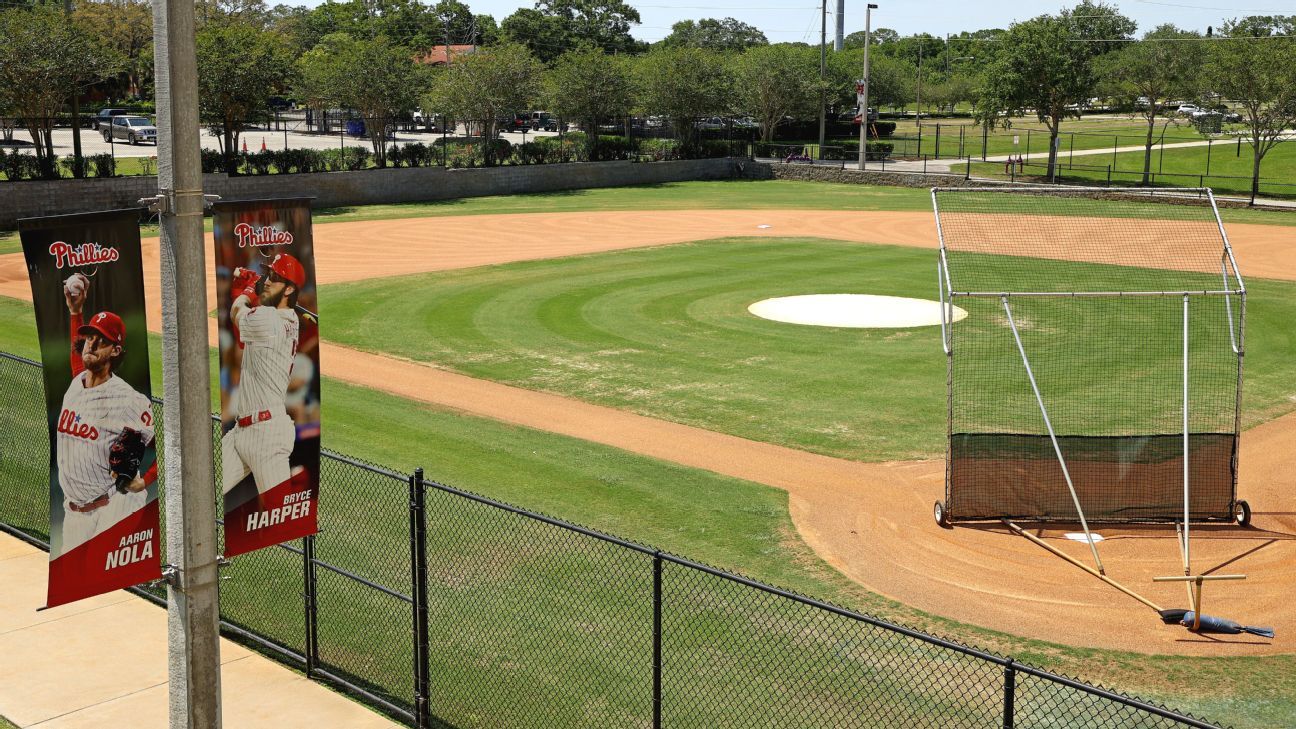Training camps around Major League Baseball officially open Friday, marking another step toward the game’s return. As momentous as that might sound, as positive as that might seem, Friday is a vital day to MLB for an entirely different reason.
The viability of a season, we’re about to learn, depends on a series of tests, and not necessarily the variety that require a nose swab. Friday’s is a litmus test — a public referendum on the results of MLB’s coronavirus intake testing. Sometime Friday afternoon, the league is expected to announce the number of positive tests for COVID-19 this week as players and staff returned to stadiums around the country. It will almost certainly number in the dozens and could hit triple digits.
The bifurcation that pollutes every conversation about the virus may well train its attention on baseball. Debates about the practicality of a season and the wisdom of returning as new daily cases reach record numbers, and whether the reasonably stable fatality rate tells a different story and on and on ad infinitum. All of it sets up a second litmus test: MLB’s ability — and desire — to handle being a very public experiment for the reopening of a business as others around the country pause or shut down.
This isn’t going away. Major League Baseball is played in the United States, and in the United States in 2020, no matter how hard people try, no matter how much safety they practice, they’re still liable to test positive for the coronavirus. Which means not just today but for the foreseeable future baseball will have COVID-19-positive players, will have the news that accompanies that and will forge forward with the idea that positive tests are simply the cost of doing business.
Until they aren’t.
That threshold remains undefined and is, not surprisingly, part of the debate taking place inside the sport too. One National League official this week wanted to be excited. Players were returning. The sounds of summer were beginning to echo in his stadium. He’d waited for this for months. And the feeling was just … empty. If it’s eventually going to shut down, he asked, why are we even bothering?
Another American League official felt those same pangs, and yet he wanted to be sanguine — and not just for sanguine’s sake, either. He saw what happened earlier this week. Minor League Baseball lost its season officially. Thousands of people lost jobs along with it. Teams were driven to insolvency. Young players will lack meaningful games for nearly 18 months. So, yeah, he said, the country may feel like a mess, but it’s the game’s duty to try to save itself. The harm in trying, in seeing whether it can maybe possibly actually conceivably work, pales next to not trying.
One veteran player was mad as hell. He was about to travel to training camp and caught a glimpse of teammates and their wives at a club. A self-narcing Instagram special. “How can this work?” he asked. “Seriously, how?” He’s far from the only one asking.
Another younger player was excited. He was returning. He was making the sounds of summer. He’d waited for this for months. And the feeling was unmatched. He would socially distance. He would stay home rather than hit clubs. He would adhere to the rules. If baseball falls apart before its 60-game season starts, it wouldn’t be because of him. He’s committed.
All of those perspectives can exist at the same time without necessarily being wrong. There is optimism and pessimism and frustration and hope. There are legitimate moral questions about the wisdom of a return and optical questions about its timing. There are fair ripostes of players making a choice to play and the league and union assembling 100-plus pages of procedures specifically so they can avoid the myriad potential trap doors.
Unless the number of positive tests from this week’s intake screenings is wildly out of whack, that first trap door should be dodged. A reasonable baseline to consider is the NBA. Of the 351 players tested in the past 10 days, 25 came back positive. At that rate, baseball would return about 125 COVID-positive players among the 1,750 or so on 60-man player pools.
If MLB exceeds that by a significant number — say doubles it — that would pose questions. How many players are asymptomatic? How long will they be out? What will they do if one person or two or more need hospitalization? That last one especially remains unanswered.
And if it’s fewer positives? No COVID case is a good case, but a lower prevalence than another league would be beneficial. Baseball plans to proceed with teams traveling from city to city and do so without punitive measures for running afoul of suggested guidelines. The NFL is considering fining players for eating out. The NBA will establish an anonymous hotline in its bubble.
MLB is putting immense faith in its testing protocol, a months-in-the-making undertaking that involved overhauling a PED-testing lab in Utah and preparing it to handle more than 14,000 tests a week. Every other day, all of the players and staff members will submit saliva samples. They’ll be shipped to the SMRTL lab in Utah, which, to process the volume of tests, will use a pooling method.
To do so, technicians will take small bits of saliva from a number of samples — say, 10 people — combine them and test the collective sample. If it comes back negative, those 10 people are safe — and it took only one test. If it returns positive, the samples from each of the 10 individuals in the pool are tested separately to identify who among them carries the virus.
The testing, of course, is not perfect — though steps taken to ensure its veracity have allayed fears that were percolating in front offices. Fears of things like false positives. PGA Tour pro Cameron Champ tested positive and was forced to withdraw from the Travelers Championship last week. His next three tests returned negative. He’s convinced the original was a bad test.
The polymerase chain reaction (PCR) test MLB uses is about 99% accurate, which, in an individual sport such as golf, makes a false positive poor luck. With baseball, the math makes a mountain of a problem. If the league is doing 14,000 tests a week, that means 1% — or 140 — would register as false positives. That’s a lot. Too many. Executives around baseball have worried a false-positive wave might hit their team and unnecessarily sideline players. The solution: The retesting of samples that come back as positive, which, barring some sort of procedural breakdown, takes that 1-in-100 chance of a false positive and reduces it drastically.
In order for there to be any chance baseball works, the testing must be almost unimpeachable. As hard as that is, it should be the easiest part because at least MLB controls it. The league does not control local municipalities or state governments or any of the other entities that can create policy limiting gatherings or closing stadiums or ostensibly neutering whatever chance baseball has at returning.
There is no good road map for this. MLB’s data on the first round of COVID-19 testing is not expected to be particularly granular. It won’t be immediately clear if one team came to training camp particularly infected — if a team had, say, 15 positives. That may come from the COVID-19 injured list, which isn’t being announced publicly but can be deduced from those who hit the IL without an announced injury. It’s odd and it doesn’t make much sense and that is so 2020 of it.
Think about it this way: A sports league is trying to return in the middle of a pandemic in which case numbers around the country are rising. On July 3, that’s where Major League Baseball is. Officially Day 1 on the comeback, getting ready for the Washington Nationals to host the New York Yankees on July 23, for Max Scherzer vs. Gerrit Cole.
Baseball is not shutting down today. It is ready for these positive tests and plenty more — ready to steer the game back. Until it isn’t.

